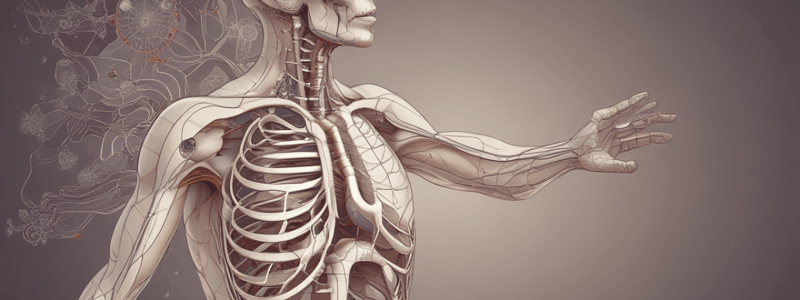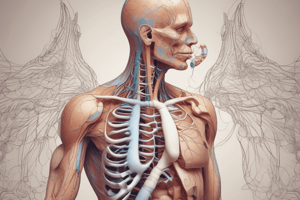Podcast
Questions and Answers
What is the primary function of the respiratory system?
What is the primary function of the respiratory system?
- To smell
- To cleanse, moisten, and warm the incoming air
- To exchange oxygen and carbon dioxide between the animal and the environment (correct)
- To conduct air from the environment to inside the body
Where does the exchange of oxygen and carbon dioxide occur in the respiratory system?
Where does the exchange of oxygen and carbon dioxide occur in the respiratory system?
- At the bronchioles
- At the air-blood interface (correct)
- At the nasal cavity
- At the trachea
What are the two crucial functions of the respiratory tract?
What are the two crucial functions of the respiratory tract?
- Air conduction and respiration (correct)
- Gas exchange and smell
- Respiration and gas exchange
- Smell and air conduction
What is the function of the conducting system?
What is the function of the conducting system?
What is the function of the transitional system?
What is the function of the transitional system?
What is the function of hair and secretions from mucous glands in the nasal cavity?
What is the function of hair and secretions from mucous glands in the nasal cavity?
What is the lower respiratory tract composed of?
What is the lower respiratory tract composed of?
How can the structures of the respiratory system be functionally subdivided?
How can the structures of the respiratory system be functionally subdivided?
What is the histological similarity between the upper and lower respiratory tracts?
What is the histological similarity between the upper and lower respiratory tracts?
What is the main difference in the histological structure of bronchi and bronchioles?
What is the main difference in the histological structure of bronchi and bronchioles?
What is the function of the smooth muscle in bronchi?
What is the function of the smooth muscle in bronchi?
What is the main function of the mixed glands in the bronchi?
What is the main function of the mixed glands in the bronchi?
What is the main difference between terminal and respiratory bronchioles?
What is the main difference between terminal and respiratory bronchioles?
What is the sequence of airway structures from proximal to distal in the lung?
What is the sequence of airway structures from proximal to distal in the lung?
What is the main function of lysozyme?
What is the main function of lysozyme?
What type of epithelium lines the bronchi?
What type of epithelium lines the bronchi?
What is the main function of mast cell-derived histamine?
What is the main function of mast cell-derived histamine?
What is unique about the walls of bronchi?
What is unique about the walls of bronchi?
What type of epithelium is found in the caudodorsal regions of the nasal cavity?
What type of epithelium is found in the caudodorsal regions of the nasal cavity?
What is the function of Bowman's glands in the nasal cavity?
What is the function of Bowman's glands in the nasal cavity?
What is the structure of the vomeronasal organ?
What is the structure of the vomeronasal organ?
What type of cells are found in the olfactory epithelium?
What type of cells are found in the olfactory epithelium?
What is the function of the vomeronasal receptor cells?
What is the function of the vomeronasal receptor cells?
What is the name of the response that facilitates the access of air to the vomeronasal organ?
What is the name of the response that facilitates the access of air to the vomeronasal organ?
What is the main function of the nasal cavity?
What is the main function of the nasal cavity?
What type of glands are found in the nasal cavity?
What type of glands are found in the nasal cavity?
What is the structure of the nasal cavity?
What is the structure of the nasal cavity?
What is the name of the pores that allow macrophages to pass from one alveolus to another?
What is the name of the pores that allow macrophages to pass from one alveolus to another?
What is the term for the space between cells as well as the microcirculation?
What is the term for the space between cells as well as the microcirculation?
What is the term for macrophages that are present within the alveolar septal interstitium?
What is the term for macrophages that are present within the alveolar septal interstitium?
What is the term for the interconnecting network of interstitial stromal tissue that supports the blood and lymphatic vessels, nerves, bronchi, bronchioles, and alveoli?
What is the term for the interconnecting network of interstitial stromal tissue that supports the blood and lymphatic vessels, nerves, bronchi, bronchioles, and alveoli?
What is the term for the dividing wall between alveoli composed of interstitium and cells?
What is the term for the dividing wall between alveoli composed of interstitium and cells?
What type of collagen is present in alveolar walls?
What type of collagen is present in alveolar walls?
What is the function of elastic fibers in the alveolar septum and interstitium?
What is the function of elastic fibers in the alveolar septum and interstitium?
What is the term for macrophages that are present within the blood vessels?
What is the term for macrophages that are present within the blood vessels?
What is the term for the barrier between the blood and air in the lungs?
What is the term for the barrier between the blood and air in the lungs?
What is the pathway of oxygen in the lungs?
What is the pathway of oxygen in the lungs?
What is the function of goblet cells in the respiratory system?
What is the function of goblet cells in the respiratory system?
What is the consequence of the absence of goblet cells due to metaplasia?
What is the consequence of the absence of goblet cells due to metaplasia?
What is the term for the buildup of fluid in the lungs?
What is the term for the buildup of fluid in the lungs?
What is the type of blood supply provided by pulmonary arteries?
What is the type of blood supply provided by pulmonary arteries?
What is the type of cells that line the visceral pleura?
What is the type of cells that line the visceral pleura?
What is the term for the change from ciliated pseudostratified epithelium to squamous stratified epithelium?
What is the term for the change from ciliated pseudostratified epithelium to squamous stratified epithelium?
What is the type of capillaries found in the lungs?
What is the type of capillaries found in the lungs?
What is the term for the contraction of smooth muscle in bronchi, bronchioles, and vessels?
What is the term for the contraction of smooth muscle in bronchi, bronchioles, and vessels?
Flashcards are hidden until you start studying
Study Notes
Respiratory System Functions
- Primary functions: smell, air conduction, and exchange of oxygen and carbon dioxide between the animal and the environment
- Respiration occurs at the air-blood interface, which lies at the most distal part of the respiratory tract
- Two crucial functions of the respiratory tract: air conduction and respiration
Upper and Lower Respiratory Tracts
- Upper respiratory tract: nasal cavity, nasopharynx, and larynx
- Lower respiratory tract: trachea, bronchi, bronchioles, and alveoli
- Histologically, the lower and upper respiratory tracts are similar, whereas regions of conduction and gas exchange differ
Functional Subdivision of Respiratory System
- Conductive (1): conduction of air from the environment to inside the body
- Transitional (2): transition zone between the conducting and gas exchange areas
- Respiratory (3): responsible for gas exchange
Conductive System
- Brings air from the environment to the respiratory portion
- Cleanses, moistens, and warms the incoming air on its way
- Hair and secretions from mucous glands in the nasal cavity trap particulate matter
Transitional System
- Transitional zone between the conducting and gas exchange areas
- Portion of the more caudodorsal regions of the nasal cavity is covered by olfactory epithelium, which facilitates the sense of smell
Olfactory Epithelium
- Tall, pseudostratified epithelium that contains three distinct cell types
- Olfactory glands (Bowman's glands) play a crucial role in the sense of smell
- Olfactory glands are tubuloalveolar glands located within the lamina propria
Nasal Cavity
- Bone-supported cavity within the skull divided by a cartilaginous septum into two halves: left and right
- Each half consists of three regions
Vomeronasal Organs
- Paired, specialized chemoreceptor organs adjacent to the nasal septum within the nasal cavity
- Structurally, the vomeronasal organ is a thick layer of sensory epithelium partially encased by cartilage and associated with an abundant vascular supply
- Histologically, the sensory epithelium is similar to that of olfactory epithelium, with a thick pseudostratified epithelium that contains three populations of cells
Bronchi
- Distally, the trachea divides into the left and right mainstem bronchi
- Histologically similar to the trachea
- Lined by ciliated, pseudostratified columnar epithelium (respiratory epithelium) and interspersed with goblet cells
- Walls are supported by cartilage plates and smooth muscle
- Bronchi have smooth muscle, which mediates bronchoconstriction
- Lamina propria of bronchi also contains moderate numbers of mixed glands (bronchial glands)
Bronchioles
- Thin-walled airways lined by variably ciliated or nonciliated columnar epithelium
- Walls are composed of tangentially arranged smooth muscle
- Lack cartilage and glands, which distinguish them histologically from bronchi
- Subdivided into terminal bronchioles and respiratory bronchioles
Alveoli
- The transition between regions of air conduction (i.e. bronchioles) and regions of air exchange (i.e. alveoli) in the lung progresses through sequentially distinct segments
- Low numbers of macrophages are normally present within the alveolar septal interstitium
- Pores of Kohn (alveolar septal pores) allow macrophage passage from one alveolus to another
Interstitium
- Composed of structural, adhesive, and absorptive components collectively referred to as the extracellular matrix
- Pulmonary interstitium is the interconnecting network of interstitial stromal tissue supporting the blood and lymphatic vessels, nerves, bronchi, bronchioles, and alveoli
Pulmonary Septum
- Dividing wall between alveoli composed of interstitium and cells
- Collagen type III is present in alveolar walls, while collagen type I is present in conducting airways
- Alveolar septum and interstitium contain elastic fibers, allowing the alveoli to stretch during inhalation and recoil during exhalation
Blood-Air Barrier
- Oxygen pathway: surfactant → cytoplasm of pneumocyte type 1 → basal lamina → cytoplasm of endothelial cell → capillary RBCs
- Carbon dioxide pathway: Capillary RBCs → cytoplasm of endothelial cell → basal lamina → cytoplasm of pneumocyte type 1 → surfactant
Pulmonary Blood Supply
- Dual blood supply: pulmonary arteries (arterioles) and bronchial arteries (from bronchoesophageal)
- Pulmonary arteries supply unoxygenated blood at low pressure, while bronchial arteries supply nutritional blood
Pulmonary Innervation
- Contraction of smooth muscle (bronchi, bronchioles, and vessels) is involuntary
Defense Mechanisms of the Respiratory System
- Goblet cells are present along the airways to the level of large bronchioles
- Increased number of goblet cells (hyperplasia) in smokers
- Absence of goblet cells due to metaplasia results in loss of immune function
Pulmonary Edema
- Refers to the build-up of fluid in the lungs (alveolar spaces filled with proteinaceous fluid)
- Gas exchange cannot take place with fluid in the alveolar space
Studying That Suits You
Use AI to generate personalized quizzes and flashcards to suit your learning preferences.




